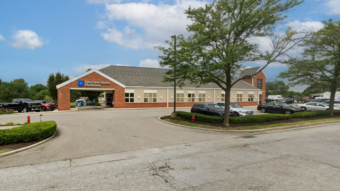For the 180+ attendees at last Friday’s annual Transportation and Logistics Conference, there was a lot of information to take in on the most dynamic sector in one of the most active markets. The speakers at the conference—the 16th one hosted by Chicago Industrial Properties—covered a lot of ground during the morning event.
The opening panel took a look at the state of the market, with Karen Lauerman, president and CEO of Lake County Indiana Economic Alliance, moderating. Joining here were Neal Driscoll, vice president, market officer, Midwest at Liberty Property Trust; Brian McKiernan, senior vice president at Centerpoint Properties; Adam Moore, senior regional director at First Industrial Realty Trust and Adam Roth, executive vice president at NAI Hiffman.
The panel discussed the performance and peculiarities of key industrial submarkets in the Chicago metro, such as how taxes and Class 6B incentives are shaping the O’Hare submarket. While the I-80 corridor has had a lot of vacancy, McKiernan noted that nationally it’s in the top three for absorption.
Improving and installing new infrastructure was another central subject, as the road, rail and airport systems are so integral to the region’s strength as a transportation leader. With so much change being driven in this space by transportation needs of e-commerce, the industry needs to focus on the requirements of third-party logistics (3PL) firms.
“The pace of change in the 3PL model is so much quicker than industrial development that we are seeing tenants modify their strategy to what’s available,” Driscoll said.
Brian Liston, president at Liston & Tsantilis P.C., moderated the second panel, which focused on construction, design and technology trends and innovations. Steve Golumbeck, vice presdent at PEAK Construction; Geoffrey Kasselman, CEO of OP2MIZE Energy LLC; Michael Larsen, managing director, development at InSite Real Estate and Cameron Trefry, LEED AP, principal at Ware Malcomb joined him for the discussion.
The discussion quickly got deep into the specific needs of industrial users, including the use of mezzanine space and the impact that has on clear height. Trefry pointed out that constructing to higher clear heights necessitates both wider column spaces and picking equipment with wider wheelbases—which ultimately affects the warehouse design.
The panelists also delved into a sector that is expected to grow exponentially—data centers. For these spaces, the general fundamentals of real estate can get turned on their head, as electricity and connectivity are greater concerns than they might be for other asset types, even other industrial uses.
“It’s not location, location, location. It’s power, power, power,” Kasselman said. “As mission critical assets, their design increasingly includes redundant infrastructure with multiple points of entry for data and power.”
The final discussion of the day, moderated by Joshua Hearne, principal at Cawley Chicago, drilled down into the investing and financing strategies affecting transportation and logistics space. Panelists included Daniel Barrins, senior vice president at Associated Bank; Rene Circ, managing director, industrial strategy at GID; Reggie Greenwood, deputy director of Chicago Southland Economic Development Corp.; Noel Liston, principal at Darwin Realty and Eric Pitcher, regional manager, economic development at BNSF Railway Company.
As it often does, the specter of Cook County taxes commanded much of the conversation. With a new assessor aiming to shift the property tax burden from residential to commercial real estate over the next few years, many in the CRE industry have been trying to gauge what those impacts may be.
“Taxes in Cook County are just too burdensome, so my clients are going into DuPage,” said Barrins. “It’s a little unnerving when we see a deal come in from Cook County, trying to peg tax as a percentage of EGI. Well see when the assessments come in where that shakes out.”
Though Cook County, and Illinois as a whole, have a poor perception among national and foreign investors, the panel agreed that the fundamentals are good enough here to still attract capital amid this bull market. “There’s way too much money trying to plow into this sector,” Circ said. “It’s impossible for it to not hit Chicago.”



